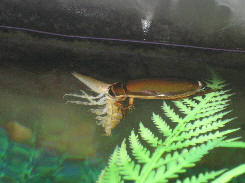|
FAQs on Aquatic Insects and Freshwater
Aquariums:
Ladies and Gentlemen; the Beetles! Related Articles:
Invertebrates in Freshwater Aquariums,
Invertebrates for Freshwater
Aquariums by Neale Monks,
FAQs on Aquatic Insects:
Aquatic Insects 1,
Aquatic Insects 2,
Aquatic Insects 3,
Aquatic Insects 4,
Aquatic Insect Identification,
Aquatic Insect Control
FAQs on Aquatic Insects by Group: Dragonflies,
Flies in General (Caddis, Gnats, Midges...),
Freshwater Mites,
Mosquitos/Mozzies and much more!
|

|
| Re: Alaskan Isopod! One Id down, now on to the
Water Beetle! 11/16/07 <Hi Jack!> Thanks for identifying
the isopod for us. <You're very welcome!> It is known
locally by Inupiat Eskimos as a "toe biter". I doubted
they had the ability to bite toes, but perhaps they actually do.
<I would imagine so. Those isopods can get relatively large -
around 3'. I sure wouldn't want one grabbing hold of my
toe!> We have a large(3 cm) water beetle living in the same
aquarium as our specimens of Saduria entomon. It preyed upon our
snails and is now preying upon the S. entomon. <Ah yes, I see.
The predator becomes the prey!> I have had trouble identifying
it and hope that you can help. <Hope so> It breathes with
head down and stores a large air bubble in its tail region.
<Typical> It is quite buoyant and uses a lot of energy to
dive. <I've seen videos of this. It looks extremely awkward,
and reminds me of trying to see how deep/far I could swim with an
inner tube around me as a kid! LOL I didn't do as well as these
insects, and I'm very thankful that there are no existing
videos to prove it! Regarding identification, unfortunately,
insects are not my strong point. What I can tell you is that since
it's a predacious diving beetle, it's most likely in the
family Dytiscidae. This family, though, has many, many genera and
species in it. The good news is that I found the following link
that supplies a list, for Alaska, that narrows it down
considerably:
http://www.uaf.edu/museum/ento/Insect_Omnibus/Dytiscidae/ The next,
tedious, step would be to go through that list and look up each
specie on the internet. If you do a search based on images, it goes
a lot quicker! I looked through about a third of those listed, and
saw one that appeared similar - Dytiscus circumcinctus. Here's
the link that shows this specie:
http://www.hlasek.com/dytiscus_circumcinctus_ac7200.html Problem
is, while it looks like yours does have something of a light border
around the anterior edges, it doesn't look like it extends all
the way around as is shown at the link. If this is indeed the case,
then it's back to old drawing board - or in this case: the
search engine!> Thanks for any help that you can provide.
<You're very welcome, I just wish I could have given you a
definitive answer!> Jack Adams White Mountain High School We are
located on the Seward Peninsula in Northwestern Alaska. <Indeed
a beautiful area, that's a fact! Take care --Lynn> |
|

|
|
|

